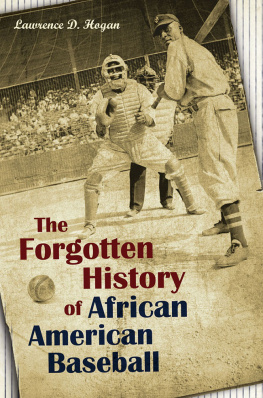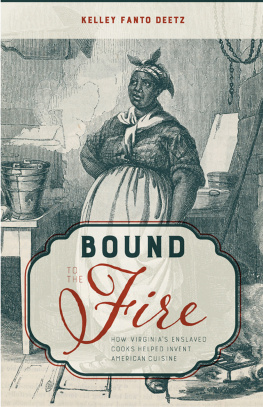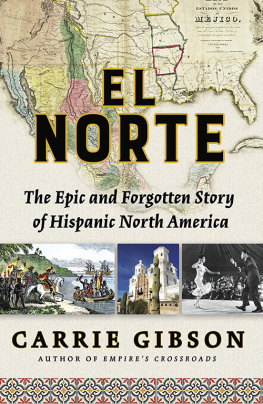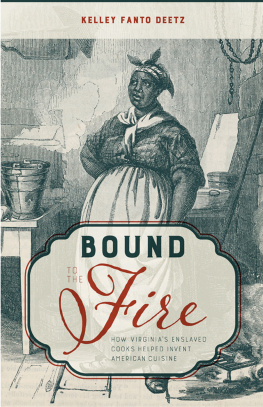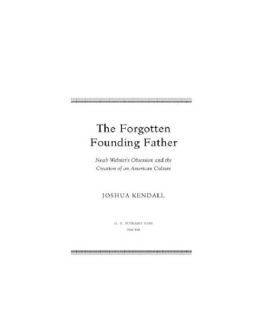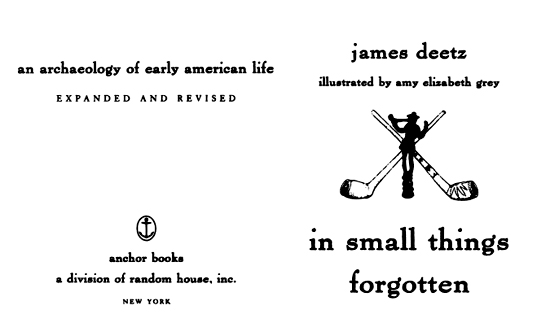FIRST ANCHOR BOOKS EDITION, 1977
EXPANDED AND REVISED ANCHOR BOOKS EDITION, 1996
Copyright 1977, 1996 by James Deetz
Illustrations copyright by Amy Elizabeth Grey
All rights reserved under International and Pan-American Copyright Conventions. Published in the United States by Anchor Books, a division of Random House, Inc., New York, and simultaneously in Canada by Random House of Canada Limited, Toronto.
Anchor Books and colophon are registered trademarks of Random House, Inc.
Library of Congress Cataloging-in-Publication Data
Deetz, James.
In small things forgotten : an archaeology of early American life / James Deetz ; illustrated by Amy Elizabeth Grey. Rev. and expanded ed.
p. cm.
1. New EnglandAntiquities. 2. New EnglandSocial life and customsTo 1775. 3. VirginiaAntiquities. 4. VirginiaSocial life and customsTo 1775. 5. Archaeology and historyNew England. 6. Archaeology and historyVirginia. I. Title.
F6.D43 1996
974.01dc20 96-1739
eISBN: 978-0-307-87438-2
www.anchorbooks.com
v3.1
contents
1. R ECALLING T HINGS F ORGOTTEN :
A RCHAEOLOGY AND THE A MERICAN A RTIFACT
To my dear friends and valued colleagues
Henry Glassie and Trish Scott
and
Henry Burlingame, Ebenezer Cooke, and
Joan Toast, my fellow Marylanders
introduction
There are times in all of our lives when things take a different turn, when we look at them from a new perspective, and depart from the path which had been followed. For me, one such time was on Halloween night, 1969, in Toledo, Ohio. I was attending an American Studies conference, where a panel discussion had been convened to consider what contribution, if any, historical archaeology might make to that field of scholarship. I was a member of the panel, as was Wilcomb Washburn; I no longer remember who the others were. Late that afternoon, I was approached by a student who asked if I had met Henry Glassie. I replied that I had not, although I had read his recently published Pattern in the Material Folk Culture of the Eastern United States and discovered for the first time the world of folk life studies and how they related to the research I had been doing. My work included studies of mortuary art in old New England cemeteries, and the excavation of a number of colonial sites in the Plymouth Colony area; but it lacked a center. It was unfocused in many ways. I had recently introduced a new course at Brown University, American Material Culture, and in the first few years that I taught it, it was similarly uncentered, being a kind of free-ranging discussion of everything from old houses to ceramics.
Henry and I were introduced in the lobby of the hotel where the conference was being held, and as is usual on such occasions, we adjourned to the bar. I learned that he had been using my Invitation to Archaeology in one of his courses, and had found it to be relevant in many ways to his research interests. So it was that a kind of intellectual fusion took place as the conversation developed, lasting through dinner. I think we both realized that we were doing much the same thing, even though we were from separate and seemingly different disciplines. From that date on, Henry and I continued what has become a twenty-seven-year collegial relationship. I have always thought of him as my intellectual mentor. I have made free use of his many ideas, and like to think that at least to some degree, the relationship has been reciprocal.
Over the next few years, the material culture course at Brown was transformed and greatly improved, due largely to my incorporating insights gained from Henry. By 1972, it had assumed the form which it was to retain through four more years at Brown, fourteen years at Berkeley, and most recently, the last three years at the University of Virginia. In 1975, I felt confident enough with the material to write it down in book form, and in 1977 it was published as In Small Things Forgotten. I have been very pleased by the reception that the book has been given, and like to think that it has provided its thousands of readers with some idea of what we do as historical archaeologists. But in the nineteen years that have passed since its first appearance, I have shifted my area of research from New England to the Chesapeake, and although I have incorporated this later work in my teaching, In Small Things Forgotten has remained largely a book on New England historical archaeology. This revised and expanded version has been produced to incorporate more recent material which has become a standard part of my course. I hope that it succeeds.
One of the more important developments in American historical archaeology during the past two decades has been the emergence of African American archaeology as a critical component of the field. The organization and content of the present book reflect this, but presenting the material does pose a problem. Is it better to discuss aspects of African American archaeology integrated with that which treats the European American experience, or should it be set apart? Both have merit, but I have chosen the latter, since I believe that in so doing, one attains a better appreciation of the way in which various facets of a cultural whole are related and integrated than if they were related piecemeal to those of another, different cultural configuration, particularly if the latter is that of the dominant group. A secondary problem is one of terminology. The reader will notice that two terms, African and African American, are used in the text in what might seem a rather random fashion. This is actually not the case. In many instances, particularly when one is discussing the seventeenth century, the probability that a significant portion of people of African descent actually were born in Africa is quite high. In other cases, one cannot be so sure. I have tried to use African in those places where I believe the people in question to have been of African origin, and African American where there is a considerable degree of ambiguity.
In the course of revising and expanding In Small Things Forgotten, I have benefited from conversations with a number of people. Some read portions of the manuscript, especially , and others made helpful and constructive suggestions on subjects ranging from African house framing techniques to the potential economic implications of inexpensive mass-produced Staffordshire ceramics. For this, I thank Anna Agbe-Davies, Alison Bell, Eric Deetz, Garret Fesler, Maria Franklin, Jeff Hantman, Bill Kelso, Nick Luccketti, Seth Mallios, Fraser Neiman, Trish Scott, Mark Warner, and Derek Wheeler. Trish Scott did a monumental job of transferring my poorly typed manuscript to disk, and setting it in a clear and concise format. Without her assistance, this book would have been at least another year in coming. At Doubleday, Papatya Bucak has been everything one could ask of an editor. Amy Grey took on illustrating the book on somewhat short notice, and did an elegant job of transforming murky photographs and sometimes less than crisp photocopies into figures which are as professional as they are lovely. Finally, I am sincerely grateful to my colleagues at the University of Virginia and the people of Charlottesville for providing an environment which made the writing of this revision a genuinely enjoyable experience.
Charlottesville
December 1995
1


